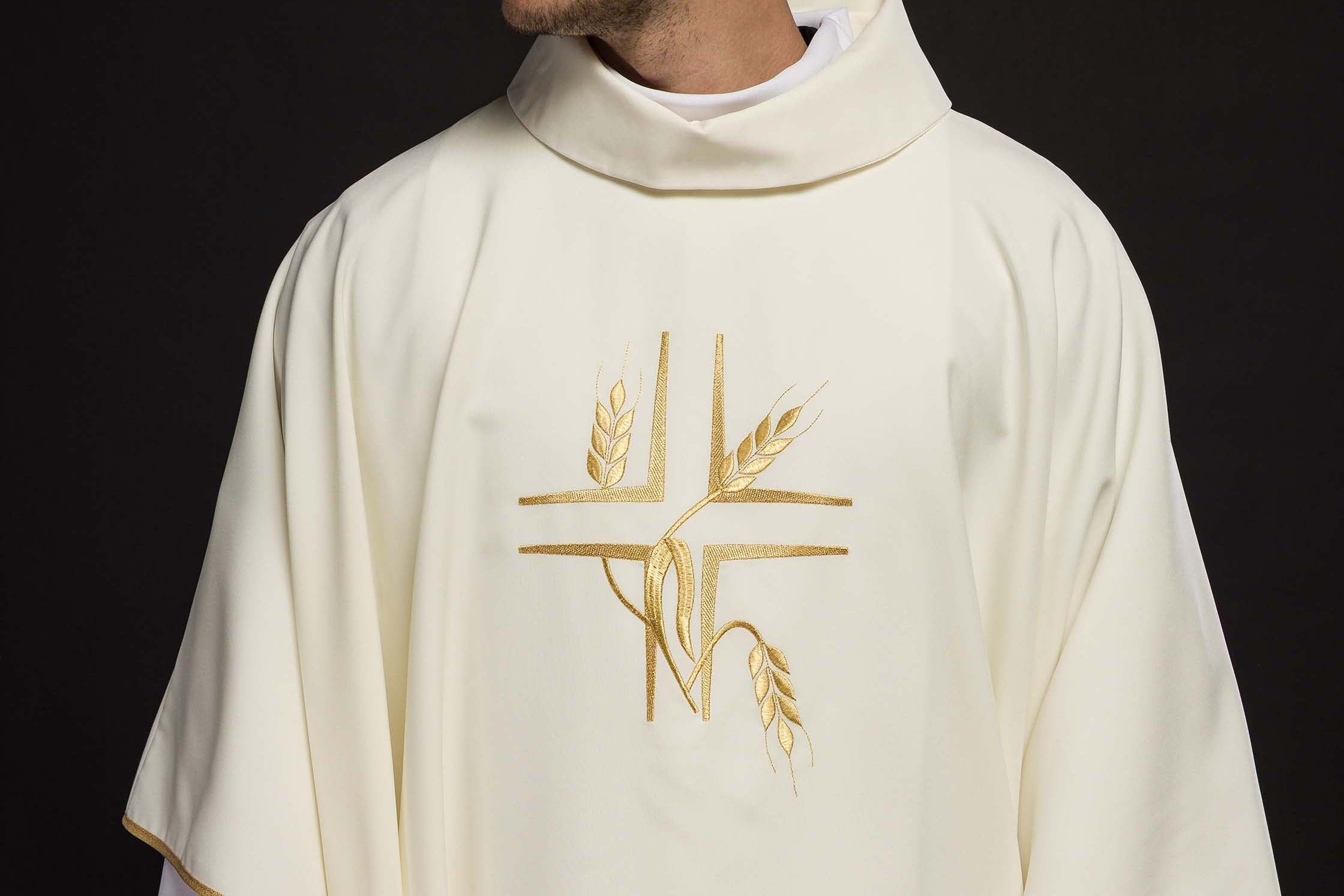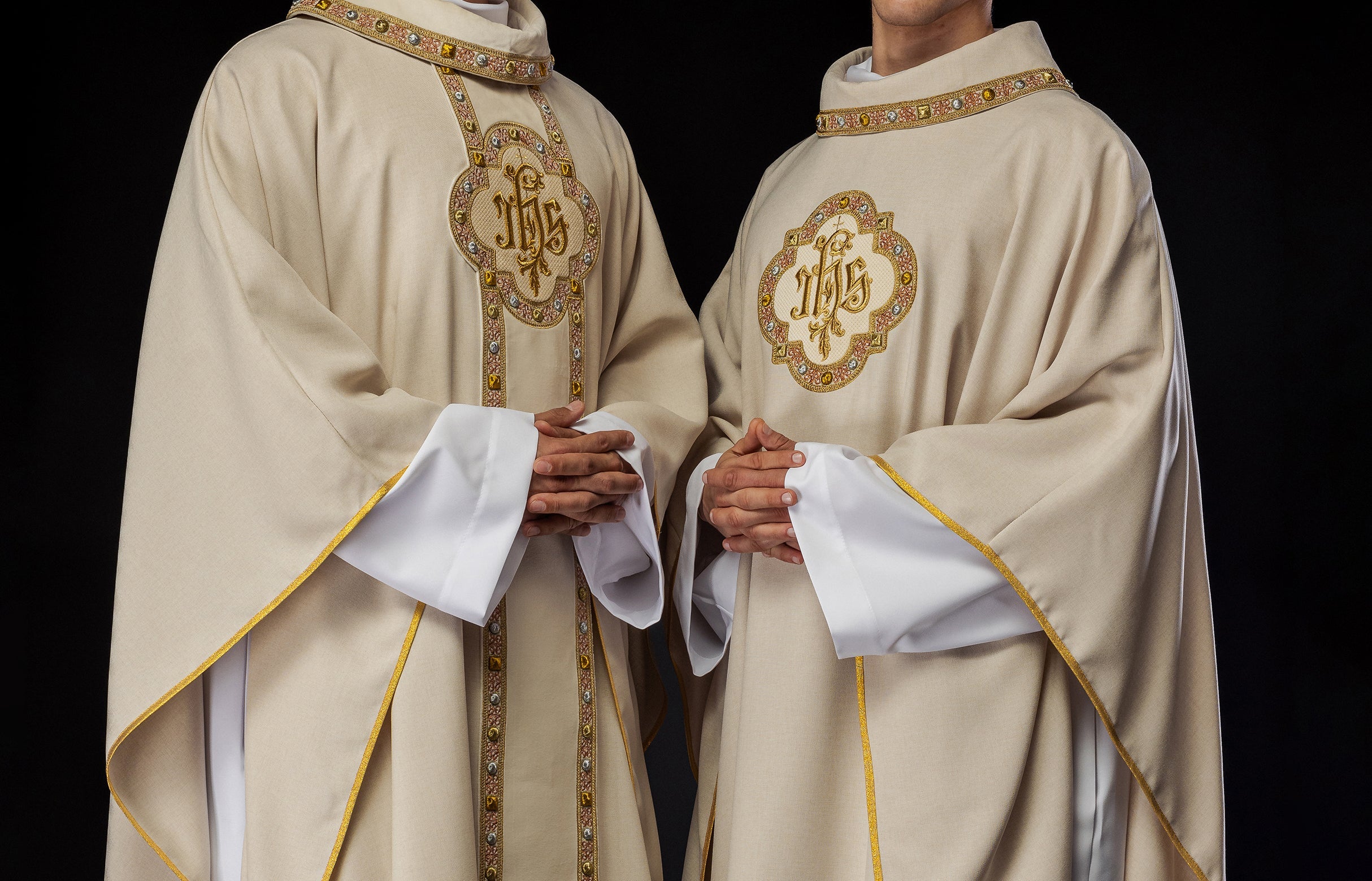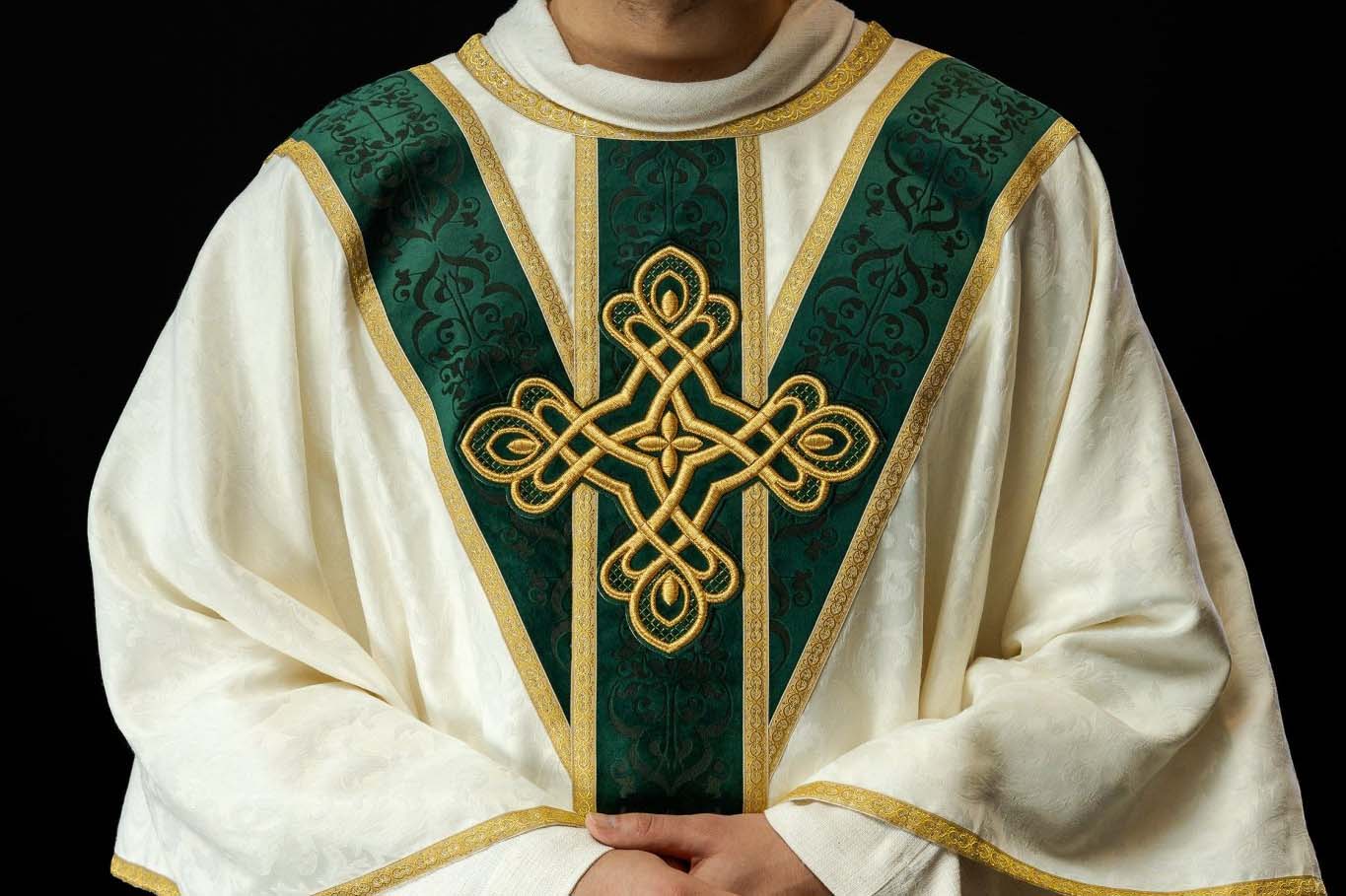
How to Choose a Chasuble as a Priestly Ordination Gift? An Inspiration-Filled Guide for Loved Ones
How to Choose an Ornate as a First Mass Gift? A Guide Full of Inspiration for Loved Ones
The First Mass, or First Holy Mass, is one of the most important events in the life of every newly ordained priest. It is the moment when, for the first time as a priest, he stands before the altar, celebrating the Most Holy Sacrifice. On this special occasion, loved ones and the community want to give him a gift that will accompany him throughout his priestly ministry. One of the most significant and valued gifts is a First Mass ornate – a symbol of his new role and the community that supports him.
What Makes an Ornate the Perfect First Mass Gift?
An ornate is not only a liturgical vestment but, above all, a symbol of the sacred priestly ministry. Choosing an ornate as a First Mass gift is an expression of respect, love, and spiritual support for the young priest. Such a gift is not only visually beautiful but, above all, carries a deep message. It is a testament to faith, hope, and gratitude for the gift of priesthood.
Why Focus on Quality and Symbolism?
An ornate that is to accompany the priest for years should be made of the highest quality materials, guaranteeing durability and wearing comfort. The symbolic meaning of the decorations and embroideries is also crucial. A properly chosen ornate can become a spiritual inspiration and a reminder of the calling.
What Types of Ornates Are Available on the Market?
The market offers a wide selection of ornates, differing in style, material, color, and type of embroidery. Understanding these differences is crucial when choosing the perfect First Mass gift.
Roman Ornates – Tradition and Elegance
Roman ornates are characterized by a classic cut, often widened towards the bottom, with a wide band running through the center and back (the so-called orant or paw). They are a symbol of tradition and the solemnity of the liturgy celebrated. They are available in many variants, from simple, smooth models to those richly decorated with embroidery.
Gothic Ornates – Modernity and Symbolism
Gothic ornates, also known as chasubles, have a simpler, more fitted cut. They are characterized by two vertical bands running from the shoulders to the bottom, joined at the waist. They are often made of patterned fabrics or with expressive embroidery, which gives them a modern character while emphasizing the sacred dimension.
Sacramental Ornates – Special Occasions
Some ornates are specially designed for specific liturgical occasions, such as holidays, patron saint celebrations, or anniversaries. Although they are not strictly intended for First Mass, they can be a beautiful addition to the young priest's liturgical wardrobe.
What to Consider When Choosing the Perfect First Mass Ornate?
Choosing a First Mass ornate is an important decision. Several key factors should be taken into account to ensure that the gift is well-received and serves the priest for years.
1. Material – The Key to Comfort and Durability
The quality of the material is of fundamental importance. It should be light, airy, and resistant to creasing, which will ensure comfort during long celebrations. Popular materials include:
- Linen and Cotton: Natural fabrics that breathe perfectly and are gentle on the skin. They are ideal for warmer months.
- Velvet: Gives the vestment a luxurious character, is soft and pleasant to the touch, but may be warmer to wear. It is perfect for solemn occasions.
- Polyester Fabrics and Blends: They are durable, resistant to creasing, and easy to care for. Modern fabrics, such as Sacrolite, are very light and airy, providing high wearing comfort.
- Jacquard Fabrics: Characterized by subtle, patterned textures woven into the structure of the material.
2. Color Scheme – The Meaning of Liturgical Colors
The colors of liturgical vestments have their deep meaning and are associated with the periods of the liturgical year. Although subdued and elegant colors are often chosen for First Mass, it is worth knowing their symbolism:
- White/Ecru: Symbol of joy, purity, innocence, holiness. Ideal for celebrations of the Resurrection of the Lord, the birth of Jesus, feasts in honor of the Mother of God and Saints who are not martyrs. Often chosen for First Mass due to its universality and symbolism of the purity of the calling.
- Gold: Similar meaning to white, emphasizes the solemn character of the celebration.
- Red: Symbolizes the Holy Spirit, martyrdom, and love. Used on feasts in honor of the Passion of the Lord, apostles, and martyrs.
- Green: Symbolizes hope and spiritual growth. Used in ordinary periods of the liturgical year.
- Purple: Symbol of penance, conversion, and expectation. Used in Advent and Lent.
- Pink: Expression of joy during the period of penance. Used on the third Sunday of Advent (Gaudete) and the fourth Sunday of Lent (Laetare).
- Blue: Symbol of peace and faith. Sometimes used on feasts in honor of the Mother of God.
- Black: Symbol of mourning and sorrow. Used on All Souls' Day and funeral liturgies.
For a First Mass gift, ornates in white/ecru or gold are often chosen, symbolizing purity, joy, and the divine light of the calling. However, if the young priest has his favorite colors or a patron saint associated with another color, it is also worth considering.
3. Embroidery and Decorations – Personalization and Symbolism
Embroidery is a key decorative element of the ornate. It can be done by computer or by hand, and its richness of patterns and motifs is enormous.
The Most Popular Embroidery Motifs on First Mass Ornates:
- IHS: The most recognizable Christian monogram, an abbreviation of "Jesus Christ Savior."
- Cross: The basic symbol of Christianity, the symbol of the Passion of the Lord and the Resurrection.
- Marian Motifs: Images of the Mother of God, the monogram MA, symbolizing care and motherly love.
- Holy Spirit: Symbolized by a dove, the seven gifts.
- Eucharistic Symbols: Ears of wheat, grapes, chalice and host, symbolizing the Body and Blood of Christ.
- Symbols of Salvation: Lamb of God, anchor (symbol of hope), fish (symbol of Christ and Christians).
- Images of Saints: The young priest's patron saint, the patron saint of the parish, saints especially venerated by him.
- Plant and Geometric Motifs: Adding elegance and symbolizing various aspects of spiritual life (e.g., eternal life).
When choosing embroidery, it is worth considering the young priest's personal preferences. Does he have a patron saint? Does he have a special devotion to the Mother of God? Is a specific symbolic message close to him?
Hand Embroidery vs. Computer Embroidery:
- Hand Embroidery: It is usually more labor-intensive, which translates into a higher price, but offers unique precision, depth, and often subtle details, e.g., decoration with natural stones.
- Computer Embroidery: Allows for the creation of complex patterns with high accuracy and in a shorter time. Modern techniques allow for obtaining very high quality embroidery.
4. Style and Cut – Matching Personality
The choice between a Roman and Gothic ornate depends on the aesthetic preferences and style that the young priest prefers. Both cuts are accepted by the Church.
- Roman ornates are more traditional and may be more solemn.
- Gothic ornates are often perceived as more modern and may provide greater freedom of movement.
It is worth discreetly finding out what vestments he already has and what style suits him better.
5. Personalization – A Unique Trace
Many companies offer the possibility of personalizing the ornate, for example, by adding an embroidered monogram, dedication, or priestly coat of arms. This option gives the gift an even more personal character and makes it a unique souvenir.
6. Additional Accessories – A Complete Set
Other elements of chalice linen, such as a stole, veil, purificator, or corporal, are often chosen for the ornate. You can consider purchasing a ready-made set or matching accessories that will stylistically and color-wise harmonize with the chosen ornate.
Where to Buy a First Mass Ornate?
When choosing a place to buy, it is worth focusing on reputable manufacturers and stores specializing in liturgical articles, such as those offering embroidered ornates. Trusted sellers guarantee high-quality products, professional advice, and the possibility of personalization.
Haftina Textile Group – Quality and Tradition
HAFTINA TEXTILE GROUP SP. Z O. O. specializes in the production of high-quality liturgical vestments, including ornates, stoles, and other accessories. They offer a wide selection of patterns, materials, and embroidery techniques, allowing for the creation of a unique and personalized First Mass gift. Available on haftinausa.com, the products combine traditional craftsmanship with modern design.
What to Consider When Purchasing?
- Opinions of Other Customers: Check what others who have already made a purchase are saying.
- Possibility of Return or Exchange: Make sure you have this option if the gift does not meet expectations.
- Order Processing Time: Especially for personalized products, it is worth ordering them well in advance.
- Quality of Embroidery and Finish: If possible, pay attention to the details that testify to the care of workmanship.
Summary – How to Make a Gift Unforgettable?
Choosing a First Mass ornate as a gift is a beautiful gesture that requires attention and heart. Remember to be guided by the quality of materials, the depth of symbolism of the embroideries, and the personal preferences of the young priest. A well-chosen ornate will not only adorn his ministry but will also be a testament to spiritual support and love from loved ones.
If you are looking for a unique First Mass ornate that will be both beautiful and deeply meaningful, we cordially invite you to familiarize yourself with the rich offer of HAFTINA TEXTILE GROUP on haftinausa.com. There you will find a wealth of patterns, colors, and personalization options that will allow you to create an unforgettable gift.
```




